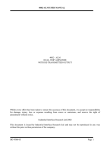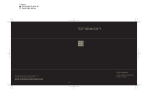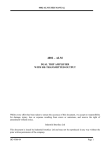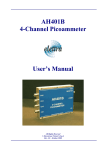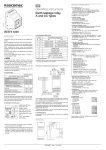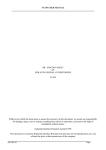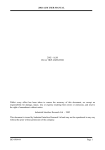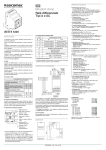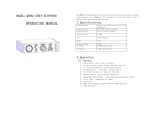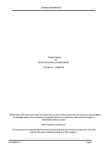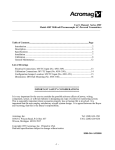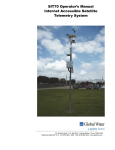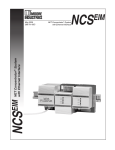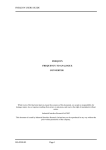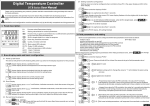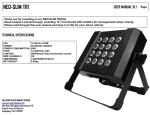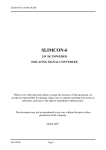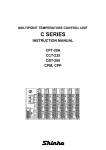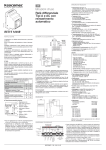Download VCON USER MANUAL
Transcript
420 TW USER MANUAL 420 FAMILY OF ISOLATING SIGNAL CONDITIONERS 420 TW SERIES Whilst every effort has been taken to ensure the accuracy of this document, we accept no responsibility for damage, injury, loss or expense resulting from errors or omissions, and reserve the right of amendment without notice. Industrial Interface Research Limited 2002 This document is issued by Industrial Interface Research Ltd and may not be reproduced in any way without the prior written permission of the company IIG-9604-02 Page 1 420 TW USER MANUAL CONTENTS Page 2 1.0 INTRODUCTION 3 2.0 UNPACKING 5 3.0 CONNECTIONS 6 4.0 RECONFIGURATION (applies to reconfigurable option units only) 7 5.0 RECALIBRATION 10 6.0 INSTALLATION 12 7.0 SPECIFICATIONS 13 IIG-9604-02 420 TW USER MANUAL 1.0 INTRODUCTION The 420 TW series is a family of isolated two wire 4 - 20 mA transmitters capable of accepting electrical input types and operating with an output loop voltage of 12 to 32 V DC. a variety of The input signal is the only parameter required to define any unit exactly. This information, together with a unique serial number, is printed on the side label of each unit; records of the exact configuration of every product shipped are maintained at the factory. 1.1 Input Types and Ranges 420 TW - HL (Previously designated 420 TW - 0 / 420 TW - 1) Accepts either voltage or current (i.e. high level) inputs. The standard default configuration of the unit allows 4 - 20 mA, 0 - 20 mA, 2 - 10 V or 0 - 10 V inputs to be reconfigured by the user. However a much wider range of inputs is available to order. In general the limits on signals that can be handled with the accuracy specified in Section 7 are: Input Types DC Current DC Voltage Input range MIN 0 - 100µA 0 - 100mV Input range MAX 0-5A 0 - 100 V AC Current AC Voltage 0 - 200µA RMS 0 - 200mV RMS 0 - 5 A RMS 0 - 70 V RMS Notes Use 420 TW-TC for V in < 100mV 45HZ ≤ f in 45HZ ≤ f in Standard process ranges such as 0 - 5 V or 1 - 5 V are of course covered. 420 TW - TC (Previously designated 420 TW - 2) Accepts inputs directly from the following thermocouple types: E,T,K,T,N,R,S,F. Temperature ranges from 0 - 100 oC to 0 - 2000 oC can be reconfigured (mV outputs without cold junction compensation can be catered for to special order). All specified ranges are 0 oC referred, although negative inputs will not damage the unit. Automatic cold junction compensation is provided. Either upscale or downscale output drive, on sensor wire break detection, can be selected. The output is not linearized. Although any thermocouple type can be selected for any temperature range, the table below indicates the ranges for which the accuracy specified in section 7 is achieved: INPUT TYPE mV J(L) K T(U) E N R S F IIG-9604-02 FULL SCALE INPUT MIN 4mV 80oC 100 oC 95 oC 65 oC 150 oC 460 oC 480 oC 100 oC NOTES MAX 100mV 1200 oC 1372 oC 400 oC 1000 oC 1300 oC 1768 oC 1760 oC 1400 oC Special order:CJC not fitted Page 3 420 TW USER MANUAL 2.0 UNPACKING Please inspect the instrument carefully for signs of shipping damage. The unit is packaged to give maximum protection but we can not guarantee that undue mishandling will not have damaged the instrument. In the case of this unlikely event, please contact your supplier immediately and retain the packaging for our subsequent inspection. 2.1 Checking the Unit Type Each unit has a unique serial number label (fig.1 below) on which full details of the configuration are given. These details should be checked to ensure conformance with your requirement. Fig. 1 - Serial Number Label Fig. 2 - Front Panel Label 3.0 CONNECTIONS Before proceeding, please check the information on the serial number label on one side of the unit to ensure that the unit configuration is correct (see Fig. 1 above). Connection details are given on the front panel label of the unit, adjacent to the relevant connections (see Fig. 2 above). 3.1 Loop Supply Voltage The voltage across the output loop terminals must not exceed 32V DC - otherwise damage to the instrument may result. The unit is protected against reverse polarity connection. Page 4 IIG-9604-02 420 TW USER MANUAL 4.0 RECONFIGURING THE INSTRUMENT (applies to reconfigurable units only) In many cases the instrument will have been factory configured to the required specifications, and calibrated, in which case this section can be ignored. If a particular configuration is not specified then the default (specified below) will be supplied. 4.1 Input Configuration This section details the steps required to reconfigure the unit, after which recalibration will be necessary. 420 TW-HL Current or voltage input can be selected to achieve any of the following DC inputs: 0-20mA 4-20mA 0-10V 2-10V (If the input is not specified at the time of order the default configuration of 4 - 20 mA will be set). B2 B1 B3 Fig.3 - Solder Bridge Link Selection Of Input Range To reconfigure the instrument remove the side cover without the serial number label from the unit - this cover is a push fit and can be prised off with a thumb nail or small screwdriver. The three links B1,B2,B3, should be open or short circuit according to the following table: Input Range 0 - 20 mA 4 - 20 mA 0 - 10 V 2 - 10 V B1 Short Short Open Open B2 Short Short Open Open B3 Short Open Short Open WARNING: TAKE GREAT CARE NOT TO DAMAGE THE DELICATE COMPONENTS ADJACENT TO THE LINKS. After reconfiguration replace the side cover. 420 TW-TC IIG-9604-02 Page 5 420 TW USER MANUAL Thermocouple type, range and wire break detect action are all user reconfigurable. (If the input is not specified at the time of order the default configuration of type K, 0 - 100oC, up scale will be set). 1 2 S3 0 S2 3 3 7 0 5 S1 5 7 S1 - Thermocouple Type 3 0 Switch Position T/C Type 0 1 2 3 4 5 6 7 8 9 E J K T N R S F - 5 7 N.B. Only Switch Position '0' Is Marked. Rotate Clockwise To Increment Position. (Diagram above shown in position 2) S2 - Range (0°-Full Scale) 0 3 7 5 N.B. Only Switch Position '0' Is Marked. Rotate Clockwise To Increment Position (Diagram above shown in position 6) Range (Full Scale) Switch Position 100 - 115 115 - 145 145 - 190 190 - 275 275 - 500 500 - 2000 0 1 2 3 4 5 6 S3 - Burnout Page 6 IIG-9604-02 420 TW USER MANUAL 1 2 Drive Switch Position Downscale Upscale 1 (Fully Anticlockwise) 2 (Fully Clockwise) (Diagram above shown in position 2) Fig.4 - Switch Selection Of Input Type, Range & Burnout (Break Detect) To reconfigure the instrument remove the side cover without the serial number label from the unit - this cover is a push fit and can be pushed off with a thumb nail or small screwdriver. Set the three switches S1,S2,S3 to the desired positions and replace the side cover. 5.0 RECALIBRATION All units are factory calibrated; although the user may wish to recalibrate with greater frequency, a two yearly recalibration interval is adequate for most applications. In the case of reconfigurable units, recalibration must be carried out after any change of configuration. 5.1 420 TW - HL With appropriate input values use front panel zero and span pots to obtain desired zero scale and full scale voltage or current output (preferably with the actual circuit loop voltage and load resistance, for greatest accuracy). It may be necessary to repeat each adjustment to ensure correct calibration. 5.2 420 TW-TC To recalibrate the unit a thermocouple simulator, (or for critical applications a millivolt source and ice-point reference) 24V DC power supply and accurate milliammeter/DMM are required: 1) Connect the equipment as shown in figure 5. - + T/C SIMULATOR - + T/C In - + 420-TW-TC Out LOOP mA + 24V dc - Fig. 5 - Calibration Circuit Note that if a T/C simulator with automatic internal cold junction compensation is used, thermal equilibrium between the simulator and the 420 TW-TC must be established. In any case the compensation applied to the simulator must be equal to the 420 TW-TC input terminal temperature. IIG-9604-02 Page 7 420 TW USER MANUAL IN S Z VR2 VR3 S = SPAN POT (VR2) OUT Z = ZERO POT (VR3) CS = COARSE SPAN POT (VR1) CS VR1 Fig. 6 - Adjustment Potentiometers 2) Referring to Figure 6, if configuration has been changed coarse range potentiometer, CS, must first be adjusted (to access VR1, remove the side cover with serial number label). (i) (ii) (iii) Set input to full scale Turn span potentiometer fully anti-clockwise to obtain minimum output current. Then adjust 6 turns clockwise Adjust CS to give nominal 20mA output (19mA<output>21mA) 3) (i) (ii) (iii) Set input to zero and adjust zero potentionmeter (marked Z on circuit board) to give 4mA Set input to full scale and adjust span potentionmeter (marked S on circuit board) to give 20mA Repeat (i) and (ii) as necessary 6.0 INSTALLATION 6.1 Installation onto Rails The instrument is designed to mount directly onto either the "Top hat" TS35 standard assembly rail to DIN 46277 part 3/EN 50022/BS5584, or the asymmetrical 32mm G-rail to DIN 46277 part 1/EN50035/BS5825. 6.2 Mounting Arrangements Ideally the unit should be mounted in a vertical position, i.e. on a horizontal rail. This is the optimum orientation to minimise temperature rise within the unit. However successful operation is possible in any orientation. Ensure the maximum ambient temperature is less than 70°C. Good airflow around the unit will maximise reliability. 6.3 Wiring Precautions The unit can accept a variety of sensor inputs, some of which produce very small signals. Therefore it is advisable to adhere to the following rules of good installation practice. (i) Do not install close to switchgear, electromagnetic starters, contactors, power units or motors. (ii) Do not have power or control wiring in the same loom as sensor wires. (iii) Use screened cable for sensor wiring with the screen earthed at one end only. (iv) Take care not to allow cut pieces of wire to fall onto the unit as they might enter via the ventilation holes and cause electrical short circuits. if in doubt, remove the units from the rail until wiring is complete. (v) Use bootlace ferrules on all bare wires. IMPORTANT: The connection terminals are designed for a maximum torque of 0.4Nm. Exceeding this figure is unnecessary and will result in unwarrantable damage to the unit. Page 8 IIG-9604-02 420 TW USER MANUAL 7.0 SPECIFICATIONS All specifications are at 20°C operating ambient with 250Ω output load and 24V loop voltage unless otherwise stated. Accuracy and Response 420 TW-HL Calibration accuracy at zero and full scale +/- 0.05% full scale Linearity +/- 0.1% full scale Zero drift + / - 50ppm full scale /°C Gain drift +/- 100ppm /°C Gain dependence on load resistance, RL +/-5ppm / Ω, 0 ≤ RL ≤ 600Ω Response Time (90% of step change) 30ms typical Output loop voltage range (RL=O) 10 to 32V DC Max Input Voltage drop (20mA input) 0.3V Input impedance (0 - 10 V input) 1MΩ 420 TW-TC Calibration accuracy at zero and full scale Cold junction compensation accuracy Linearity (with respect to thermocouple voltage) Zero Drift Gain Drift Gain dependence on load resistance, RL Response time (90% of step change) Output loop voltage range (RL=O) Sensor break detect current +/- 0.2% full scale +/- 2 °C over operating temperature range +/- 0.1 % full scale +/- 50ppm full scale /°C +/- 100ppm /°C +/-5ppm / Ω,0 ≤ RL ≤ 600Ω 300ms typical (higher speed version available) 11 to 32 V DC +/- 250nA Power Supply Isolation and Operating Ambient (all types) 7.1 Operating Voltage 11 - 32 V DC Current 29 mA maximum overscale Input to output isolation 1kV DC Operating temperature range -15 - 70°C Storage temperature range -40 - 100°C Operating and storage humidity range 0 - 90% RH EMC performance 420 TW-HL The 420 TW-HL conforms with the protection requirements of Council Directive 89/336/EEC on the approximation of the laws of members states relating to electronic compatibility (Article 10 (1)): 1) Radiated Emissions: The unit meets EN55011: 1991 (Group 1, Class B) and EN55022: 1987 (Class B) 2) EMC Immunity: IIG-9604-02 Page 9 420 TW USER MANUAL The unit meets EN50082-2: 1995 as follows: (i) ESD Immunity: Performance is not degraded by 8 KV ESD to ground in the vicinity of the unit. Direct ESD greater than 4 KV to the connection terminals or adjustment pots of the unit should be IMPORTANT: Service/ Maintenance personnel should take care to discharge themselves to the control cabinet/ systems earth before wiring, adjusting or calibrating the unit. (ii) RF Immunity: The output of the unit varies by less than +/- 1% full scale with fields of 10Vm-1 with 80% A.M. at 1KHZ, between 800KHz and 1 any field orientation. avoided. GHZ with (iii) Fast Transient Immunity: During transients of 2 KV the outputs are temporarily affected and may vary by up to 1% full scale. Hence the unit is suitable for both “Light industrial” and “Industrial” environments. 420 TW-TC The 420 TW-TC conforms with the protection requirements of Council Directive 89/336/EEC on the approximation of the laws of members states relating to electronic compatibility (Article 10 (1)): 1) Radiated Emissions: The unit meets EN55011: 1991 (Group 1, Class B) and EN55022: 1987 (Class B) 2) EMC Immunity: The unit meets EN50082-1: 1992 as follows: (i) ESD Immunity: Performance is not degraded by 8 KV ESD to ground on the vicinity of the unit. Direct ESD greater than 4 KV to the connection terminals or adjustment pots of the unit should be IMPORTANT: Service/ Maintenance personnel should take care to discharge themselves to the control cabinet/ systems earth before wiring, adjusting or calibrating the unit. (ii) RF Immunity: The output of the unit varies by less than +/- 1% full scale with fields of 3Vm-1 CW between 800KHz and 500 MHz with any orientation. field (iii) Fast Transient Immunity: During transients of 500V the output varies by less than +/- 1% full scale Hence the unit is suitable for the “Light industrial” environment. Page 10 avoided. IIG-9604-02











